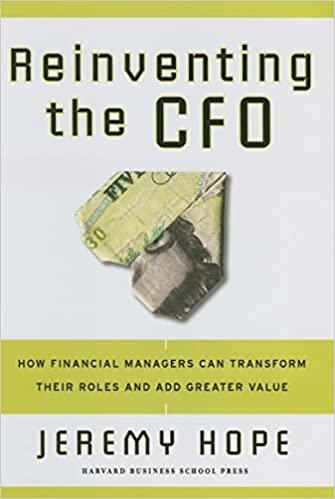Question
1- Capital budgeting involves planning and justifying how money is spent on short-term items like inventory, and payroll as well as on long-term projects such
1- Capital budgeting involves planning and justifying how money is spent on short-term items like inventory, and payroll as well as on long-term projects such as new business ventures, equipment replacement, and expansion.
True
False
2- The cost of capital is a single rate that reflects the average return paid to investors who provide the firm's capital.
True
False
3- The NPV decision rules are based on the following statements that follow from the definition of NPV.NPV > 0 , adds shareholder wealthNPV = 0, no change in shareholder wealthNPV < 0, reduces shareholder wealth
True
False
4- The internal rate of return is analogous to the yield on a bond, because both are rates that equate inflows with outflows on a present value basis.
True
False
5- An assumption implicit in the net present value technique is that all cash flows are reinvested at the cost of capital.
True
False
6- Although the NPV method is technically superior, the IRR method is used more frequently.
True
False
7- The least risky capital projects are replacements. Expansions and new business ventures are progressively more risky.
True
False
8- Which of the following is not a cash flow consideration in evaluating capital budgeting projects?
| a)income taxes on incremental earnings | ||
| b)identifiable incremental overhead | ||
| ic)ncremental accounting profit (net income) | ||
| d) depreciation |
9 -When estimating cash flows for capital budgeting projects,
| a)interest expenses incurred to finance the project are included | ||
| b)interest expense is considered in the cash flow estimates only if the financing is principally from debt | ||
| c)interest expense is never included in the cash flow estimates | ||
| d) none of the above |
10- The most difficult part of the capital budgeting process is:
| a)estimation of the incremental project cash flows | |||||||||||||||||||||||||||||||||||||||||||||||||||||
| b)application of evaluation techniques such as NPV or IRR | |||||||||||||||||||||||||||||||||||||||||||||||||||||
| c)interpreting the results of the application of NPV or IRR | |||||||||||||||||||||||||||||||||||||||||||||||||||||
| d) none of the above 11- Because depreciation is a non-cash expense item, it is not necessary to consider depreciation in estimating cash flows for a new capital project. True False
12- An increase in net working capital increases operating cash flows. True False
13- The incremental cash flow principle claims that sunk costs must be taken into account in the firm's decision whether to accept or reject a project. True False
14- Basic overheads are usually considered fixed and left out of project analysis. True False
15 - The terms "acquisition" and "takeover" are often used to refer to a merger because the stock of the firm that goes out of existence is usually acquired by the continuing firm. True False
16- A consolidation occurs when all of the combining legal entities dissolve, and a new entity with a new name is formed to continue into the future. True False
17 - Acquiring firms rarely pay more than a small premium over their target's premerger market price, because to do so would be an irrational transfer of wealth to the target's stockholders. True False 18 - If Company F and Company G merge and become Company F, what happens to the stockholders of Company G?
19 -The category of business combination where the firms have a supplier-customer relationship is known as a
20 -A combination of companies that compete directly is a
|
|
|
|
|
Step by Step Solution
There are 3 Steps involved in it
Step: 1

Get Instant Access to Expert-Tailored Solutions
See step-by-step solutions with expert insights and AI powered tools for academic success
Step: 2

Step: 3

Ace Your Homework with AI
Get the answers you need in no time with our AI-driven, step-by-step assistance
Get Started


